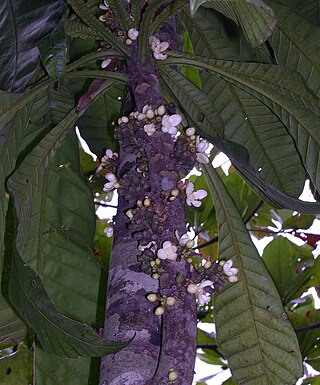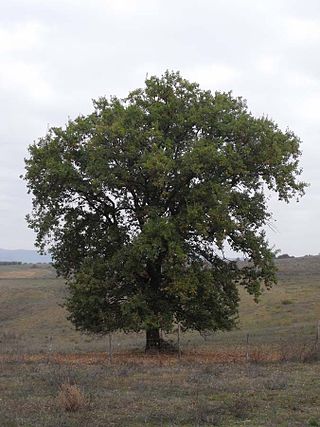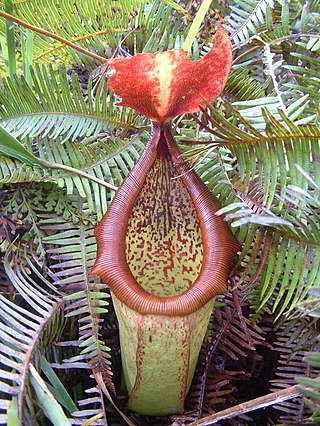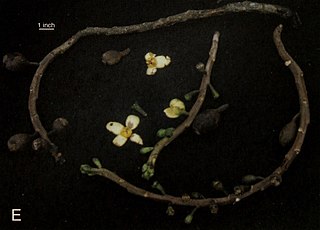
Grias cauliflora, the anchovy pear, is an evergreen fruit tree native to Jamaica, Central America, and Colombia. It is often found near rivers or marshes in large colonies. It belongs to the Lecythidaceae family.

Quercus pubescens, commonly known as the downy oak, pubescent oak or Italian oak, is a species of white oak native to southern Europe and southwest Asia. It is found from northern Spain (Pyrenees) and France in the West to Turkey and the Caucasus in the East.

Pachypodium baronii, the Madagascar palm or bontaka, is a flowering plant in the family Apocynaceae. It has the habit of a robust shrub with a spherical or bottle-shaped trunk. It has several cylindrical branches at the top.

Couroupita guianensis, known by a variety of common names including cannonball tree, is a deciduous tree in the flowering plant family Lecythidaceae. It is native to lowland tropical rainforests of Central and South America, from Costa Rica, south to Brazil and northern Bolivia and it is cultivated in many other tropical areas throughout the world because of its fragrant flowers and large fruits, which are brownish grey. There are potential medicinal uses for many parts of Couroupita guianensis, and the tree has cultural and religious significance in South and Southeast Asia. In Sri Lanka and India, the cannonball tree has been widely misidentified as the Sal tree, after its introduction to the island by the British in 1881, and has been included as a common item in Buddhist temples as a result.

Grias is a genus of flowering plants in the family Lecythidaceae, described by Linnaeus in 1759. It is native to northwestern South America, Central America, and Jamaica.

Nepenthes klossii is a tropical pitcher plant endemic to New Guinea.

Nepenthes jacquelineae is a tropical pitcher plant endemic to the Indonesian island of Sumatra. Due to its unique pitcher morphology, it is considered to be one of the most spectacular Nepenthes species native to the island.

Nepenthes rigidifolia is a critically endangered tropical pitcher plant endemic to Sumatra, where it grows at elevations of 1000–1600 m above sea level.

Nepenthes insignis is a tropical pitcher plant endemic to New Guinea and surrounding islands. The specific epithet insignis is Latin for "distinguished" or "remarkable".

Tsuga chinensis, commonly referred to as the Taiwan or Chinese hemlock, is a coniferous tree species native to China, Taiwan, and Vietnam. The tree is quite variable and has many recognised varieties, though some are also maintained to be separate species by certain authorities. The tree was recently discovered in the mountains of northern Vietnam, making that the southernmost extension of its range.
Couratari asterotricha, also known as imbirema, is a species of plant in the family Lecythidaceae. It is a critically endangered species endemic to Brazil.
Couratari longipedicellata is a species of rainforest tree in the Monkeypot Family (Lecythidaceae). It is found only in Brazil. It is threatened by habitat loss. Perhaps its most remarkable feature is its very large seeds; up to 9.5 cm long by up to 2.3 cm wide.
Grias colombiana is a species of woody plant in the family Lecythidaceae. It is found only in Colombia.
Grias haughtii is a species of woody plant in the Monkeypot family Lecythidaceae. It is found only in Colombia in non-flooded lowland forests. Its most remarkable feature is its leaves, which can be up to 5.5 feet in length by 16.5 inches in width. It also produces exceptionally large seeds, up to 2.7 inches (69 mm) in length by one inch (25 mm) in diameter.

Grias longirachis is a species of woody plant in the family Lecythidaceae. It is found only in Ecuador. Its natural habitats are subtropical or tropical moist lowland forests and subtropical or tropical moist montane forests.
Lecythis ollaria is a species of tree found growing in forests in Brazil, Guyana, and Venezuela. The tree is known locally as coco de mono, and accumulates selenium in its tissues.

Mangifera zeylanica, or Sri Lanka wild mango, is a wild species of mango relative endemic to Sri Lanka. This stately tree is the tallest member of the mango genus, Mangifera, and one of the two tallest trees in the family Anacardiaceae. The mango fruits are edible and have an excellent taste. It is called "aetamba" (ඇටඹ) or "wal amba" in Sinhala and “kaddu-ma” in Tamil. The well-known British botanist and explorer Joseph Dalton Hooker first described the tree in 1876.

Lecythis zabucajo, the sapucaia or paradise nut, is a large nut-producing tree occurring in the Guianas, Suriname, Venezuela, Ecuador, Honduras and Brazil, and which distribution range is much the same as that of the greater spear-nosed bat. Although not singling out Lecythis zabucajo, Jacques Huber noted in 1909 that fruit bats played the most important role in seed dispersal in Amazonian forests. The quality of its nuts led to the species' being introduced to numerous tropical countries, notably Trinidad, where it has flourished. The nuts are a valuable food resource and yield oil suitable for cooking and domestic use.
Madhuca multinervia is a tree in the family Sapotaceae, native to Borneo. The specific epithet multinervia means 'many-veined', referring to the leaves.

Petersianthus quadrialatus is an emergent tropical rainforest tree species in the Lecythidaceae family. In the Visayas region called kapullan, in the Samar and Leyte areas - magtalisai. It is an indigenous tree species in the southeastern Philippines and one of the largest tree species in the Philippines islands.














